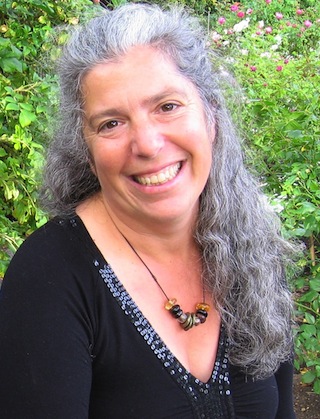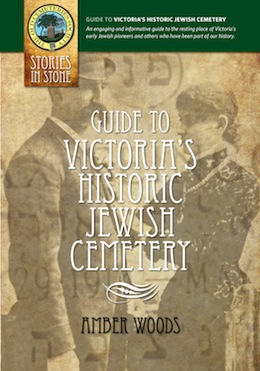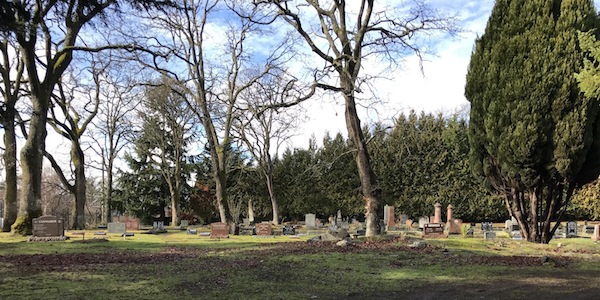Victoria’s historic Jewish Cemetery. (photo from Amber Woods)
Who could imagine that a book about a cemetery would be so full of life? But then, the people who populate Amber Woods’ Guide to Victoria’s Historic Jewish Cemetery (Old Cemeteries Society, 2018) were among the most vivacious of sorts, starting with the daring, westward-bound pioneers eager to start a new life on a new frontier, to those who went on to be well-known judges (Samuel Schultz), politicians (David Oppenheimer) and artists (Reuven Spiers). Written on the cemetery’s gateway, the phrase Beit HaChayim (House of the Living) welcomes visitors.
The cemetery has had a storied existence. There have been fires, upkeep challenges, pleas to the public to locate graves of prominent individuals and, sadly, in recent times, the desecration of five gravesites in late 2011.

The discovery of gold along the Fraser River in 1858 brought an influx of people to the region, mostly from California, Jews among them. Jews arrived largely as merchants and proved adept at figuring out what was needed in the community. Having already developed trading networks, they did not need to rely on the Hudson’s Bay Co. (HBC) for supplies or for getting their goods to other markets, and “could move quickly from one business to another.”
On May 29, 1859, a group met to create the basis of a Jewish community, including a synagogue and a cemetery, in Victoria. A cemetery committee was formed and, on Oct. 1 that year, 1.7 acres of land was purchased from Roderick Finlayson, the chief factor of the HBC. In February 1860, the cemetery was consecrated, making it the first Jewish cemetery – and the oldest non-indigenous cemetery – in continuous use in Western Canada.
The first funeral at the cemetery, on March 20, 1861, was the result of a most unsavoury encounter. Businessman Morris Price, an immigrant from Prussia, was in his shop in Cayoosh, what is now Lillooet, on Feb. 1, 1861, when three men entered. He was found dead the next day. All the perpetrators were found guilty; two were executed, the third convicted of manslaughter and given a shorter 12-month sentence for his cooperation with officials. As Victoria’s was the only Jewish cemetery at the time in the region, Price’s remains were sent from the mainland.
Herein, too, are remembered several who were prominent in Victoria’s early commercial hub – liquor salesman, saloon operator and real estate tycoon Max Leiser; clothier Frederick Landsberg, who learned Chinook to trade with First Nations people and who would later go into curios, real estate and, finally, philanthropy; and restaurateur H.E. (Henry Emanuel) Levy, who opened the first gourmet establishment in the Pacific Northwest, the very “unkosher” sounding Levy’s Arcade Oyster Saloon, which became a local hangout. Levy’s son, Arthur, followed in the family business, setting up various popular diners, such as the Poodle Dog Café. Once retired from the restaurant business, Arthur Levy began a mission of world peace, which saw him correspond with many a noted statesman of his time, including Nikita Khrushchev, David Ben-Gurion and Jawaharlal Nehru.
Many of those buried at Victoria’s historic Jewish Cemetery lived the sort of life that could have been turned into a novel or film – tales of shipwrecks, of bankruptcies turned into successes.
There are fascinating biographies, such as that of Samuel Schultz, who, despite living to be a mere 51 years of age, did more in those years than most do in a lot longer. Schultz was a musician, athlete, activist and lawyer. He is credited with pitching the first no-hitter in British Columbia, played flute and clarinet for the Victoria Symphony, composed music, served as a correspondent for several newspapers and was a founding member of the Independent Order of B’nai B’rith and became the first Jewish judge in Canada.
 Then there is Lewis Lewis, who served twice, in non-consecutive terms, as one of the first presidents of Victoria’s Temple Emanu-El (now Congregation Emanu-El). His is a story shrouded in questions. “Much of the information available about Lewis Lewis is contradictory, incomplete or, in some instances, false,” Woods writes. Many myths and mysteries exist about this early Jewish settler, from his place of birth in Eastern Europe to how he changed his name, from the story of his arrival in Victoria, to his legacy within the local community.
Then there is Lewis Lewis, who served twice, in non-consecutive terms, as one of the first presidents of Victoria’s Temple Emanu-El (now Congregation Emanu-El). His is a story shrouded in questions. “Much of the information available about Lewis Lewis is contradictory, incomplete or, in some instances, false,” Woods writes. Many myths and mysteries exist about this early Jewish settler, from his place of birth in Eastern Europe to how he changed his name, from the story of his arrival in Victoria, to his legacy within the local community.
The historic Jewish Cemetery is situated four kilometres from downtown Victoria, where Fernwood Road meets Cedar Hill Road. Visitors enter through the pedestrian gate of the main entrance.
Woods’ book is part of the Stories in Stone series organized by the Old Cemeteries Society. Copies can be purchased at the Jewish Community Centre of Victoria, Congregation Emanu-El, area bookstores (Bolen, Munro’s and Ivy’s) and online at jewishvictoria.wordpress.com.
Sam Margolis has written for the Globe and Mail, the National Post, UPI and MSNBC.

